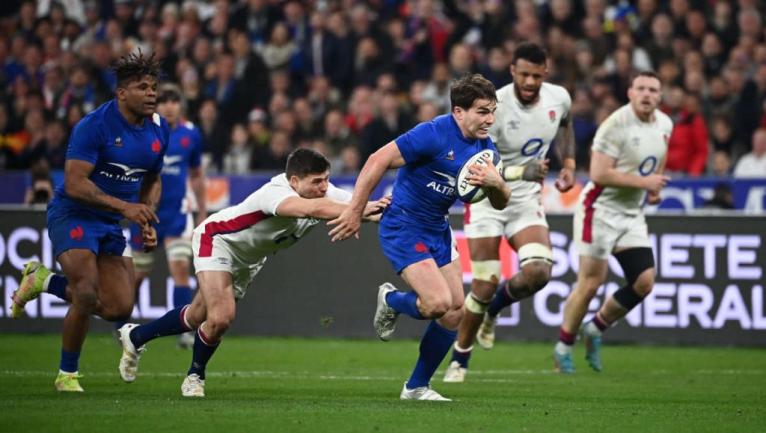France have sent a clear message to the rugby world in the last 12 months. Indeed, anyone who argues that Les Bleus were not the best team in the Six Nations weren’t watching properly. Their performances were consistent, well-balanced and thrilling. So much so that the so-called two tiers of Six Nations rugby might be considered to be France and Ireland versus the rest, although the other nations may beg to differ.
So why have France edged ahead as the leading Northern Hemisphere country? Looking at the equilibrium between defence and attack alone makes it difficult to put a finger on the exact nature of France’s superiority.
France in Possession: Carry Pass Kick
Before the tournament began, one of the big questions concerned which kind of French side would turn up, an age-old cliche, lessening the longer Shaun Edwards is in involved the French set-up. In recent history, France have excelled as a running side, showcasing their best abilities with ball-in-hand. But they also have a reputation as an inconsistent Test nation. It’s not uncommon to watch a Jekyll and Hyde situation unfold for France across a Six Nations campaign. Take their game against Scotland last year. With the game won, all Brice Dulin had to do was hoof the ball into row-Z, but he dithered, Scotland regained possession and won the game through a Stuart Hogg try. With so many promising young players in their squad – formed from the successful U20 sides of 2018 and 2019 – more inconsistencies might have been forgiven as a side in transition. But with the Grand Slam secured, 2022 brought quite the opposite happened for France in the Six Nations. They were the most consistent performers in the tournament. This high level of consistency forms the basis of a realistic tilt at a World Cup triumph for the French next year on their home turf.

An inspection of the pass-carry-kick ratio, measuring French decision making in possession, shows the faith that this side has in its ball carriers across the field. The French carried more than any other side in this year’s Six Nations and passed the ball on the fewest occasions. The importance of the French backrow to their performance in possession can’t be overemphasised here. No 8 Gregory Aldritt carried 65 times, the most of any player in the tournament and nine more times than Stuart Hogg (56), who ranks second on this list.

Turnovers
Another strong aspect of France’s play, so often linked to Six Nation winning sides, was a ruthless attitude to turning the ball over. France were clinical and acquired a grand total of 96 turnovers in their five Test matches. Aldritt, again, is building an international reputation that sets him apart as one of the best back-row players on display at the World Cup in 2023. He was the difference at breakdown on numerous occasions. With six turnovers, he tops this particular ranking at the Six Nations this year (alongside Maro Itoje, Toa Halafihi and Alex Dombrandt). Jonathan Danty, who put in a series of impressive performances, comes second with five.
The synergy between attack and defence combined with this ability to turn over the ball is the driving force that keeps the French machine ticking over. Test sides throughout the Six Nations this year were looking for quick ruck ball. Time spent at the breakdown was undesirable and it was the effectiveness of Fabien Galthié’s side in this area that acted as the anchor between attack and defence.

Line Breaks
A closer look at the statistics behind France’s attacking play goes some way to explaining their emphasis on keeping ball in hand. French backs and forwards alike were brutal when it came to breaking the gainline and disrupting defences. Collectively, they notched up a total of 38 line breaks throughout the competition, ten more than runners up Ireland.

Ninety-five per cent of these line breaks happened within 18m of a touchline. These were targeted attacks intended to dismantle defensive structures from the flanks. Gabin Villière was the first line of attack in this sense and accumulated a total of 12 line breaks for the entire tournament, the most of any player, even though he missed the Wales game. Damian Penaud sits at third on this list with eight linebreaks to his name.
Discipline
Looking ahead to the challenge facing this exciting French Test side at the World Cup next year, it may well come down to how disciplined they can be in the knock out rounds. So often tightly fought matches on the biggest stage in rugby amounts to how well players can keep their head under pressure. Penalties, yellow and red cards will cost nations their place in the knock-out stages. For instance, it’s impossible to ignore the influence of Charlie Ewels’ early red card for England on their performance against Ireland in the Six Nations.
Discipline was relatively good throughout the competition with only seven cards being shown in total. Notably neither Ireland nor France, the tournament’s two top sides, received a yellow or a red card. Instead, time in the bin was mainly reserved for the bottom half of the Six Nations table with Scotland, in Finn Russell and Ben White, being the only side to pick up more than one card.

It is an exciting time to be following French rugby. Les Bleus have incredible generational stars like Dupont, Ntamack, Penaud, Aldritt and more, who are shaping up to be the best players in the world in each of their positions at exactly the right time. What’s more they are a nation with substantial strength in depth and more exciting players yet to break through. With a year to go until the World Cup, France need only to continue the trend they have set for themselves this year at the Six Nations. The rest is down to luck.



Comments
Join free and tell us what you really think!
Sign up for free